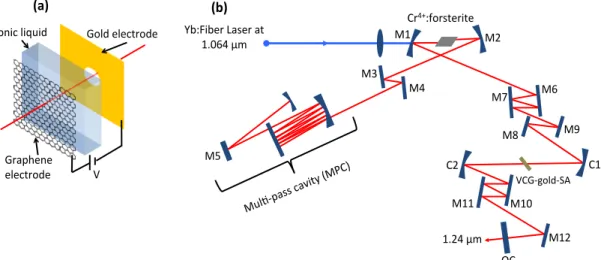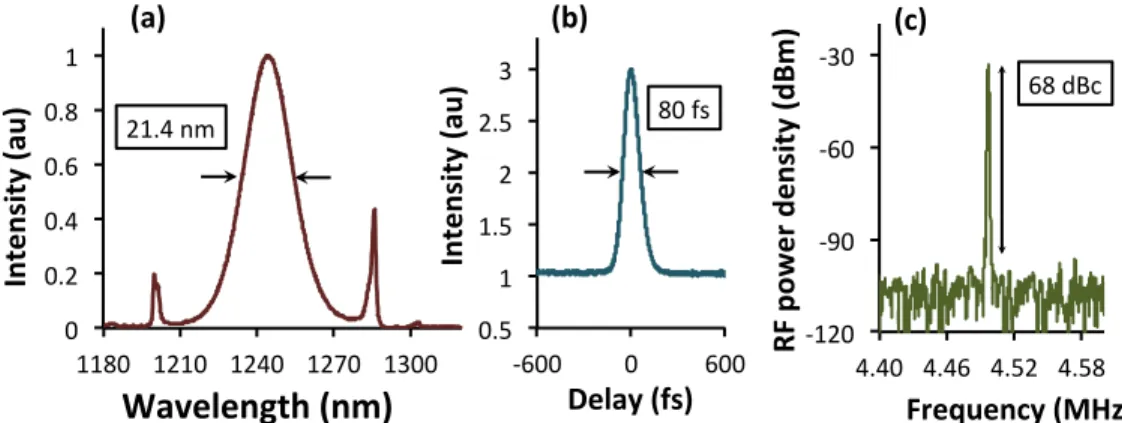AW1A.1.pdf Advanced Solid State Lasers Conference © OSA 2015
Graphene-Gold Supercapacitor As a Voltage-Controlled
Saturable Absorber for Femtosecond Pulse Generation
I. Baylam1, O. Balci2, N. Kakenov2, C. Kocabas2, and A. Sennaroglu1,*
1 Laser Research Laboratory, Departments of Physics and Electrical-Electronics Engineering, Koç University, Istanbul 34450, Turkey
2 Department of Physics, Bilkent University, Ankara 06800, Turkey
*Corresponding author: asennar@ku.edu.tr
Abstract: We report, for the first time to our knowledge, a voltage-controlled graphene-gold supercapacitor saturable absorber, as a modulator with adjustable insertion loss for low-gain mode-locked lasers. Nearly transform-limited, 80-fs pulses were generated near 1240 nm.
OCIS codes: (140.4050) Mode-locked lasers; (140.7090) Ultrafast lasers; (160.4236) Nanomaterials; (140.5680) Rare earth and transition metal solid-state lasers.
1. Introduction
In recent years, graphene has emerged as a versatile saturable absorber for femtosecond pulse generation. Owing to its broad, nearly constant absorption band as well as ultrafast response, it has been possible to demonstrate mode-locked operation of a wide variety of near- and mid-infrared lasers with graphene [1, 2]. Despite these favorable optical characteristics and simple fabrication schemes [3, 4], one remaining challenge is that, once inserted into a resonator, even monolayer graphene introduces about 5% of small-signal round-trip loss, considerably reducing the efficiency of low-gain lasers (such as Cr:forsterite and colquiriites) containing intracavity graphene saturable absorbers. To obviate this problem, several approaches incorporating graphene based solid-state or supercapacitor structures have been proposed and successfully demonstrated in recent years to reduce the amount of absorption in graphene, while maintaining a sufficient level of saturation to initiate mode-locked operation. Graphene based solid-state capacitors have been shown to operate with a variable level of absorption, but their operation was limited to the infrared wavelengths [5, 6]. In the case of a graphene-based supercapacitor, which was first demonstrated as a variable saturable absorber by our groups, due to the use of an organic electrolyte with high dielectric constant and due the formation of an ultrathin electric double layer at the graphene-electrolyte junction, the Fermi level can be readily shifted to reduce the absorption up to the visible region with low bias voltages of the order of several volts [7]. A graphene based supercapacitor structure has been recently demonstrated by our groups as a voltage controlled saturable absorber to generate femtosecond pulses from a Cr:forsterite laser near 1250 nm [8]. This experiment clearly indicated that it is possible to reduce the passive losses of graphene while maintaining sufficient saturation for mode-locked operation. One drawback of the supercapacitor design in Ref [8] was that both of the electrodes were made of graphene, resulting in an additional 5% insertion loss and requiring higher pump powers to obtain mode-locked operation. The overall performance of the graphene supercapacitor can be considerably enhanced if a capacitor design incorporating only one graphene electrode is developed.
Here, we report the first demonstration of a novel, voltage controlled graphene device for mode locking: voltage controlled graphene-gold supercapacitor saturable absorber (VCG-gold-SA). Since the VCG-gold-SA design contains one graphene electrode and one gold electrode, the insertion loss is reduced in comparison with that of the supercapacitor having two graphene electrodes [8]. A circular hole formed on the gold electrode allows the passage of the beam through the device. Our experiments clearly demonstrated that as the bias voltage of the VCG-gold-SA was increased, mode locking could be obtained with lower pump powers. By using the VCG-gold-SA inside a multipass-cavity Cr:forsterite laser, nearly transform-limited 80-fs pulses could be generated near 1240 nm. 2. Experimental Setup and Results
Figure 1 (a) shows the schematic drawing of the voltage-controlled saturable absorber which consists of a room temperature ionic liquid electrolyte (Diethymethyl (2-methoxyethyl) ammonium bis (trifluro- methylsulfony) imide [DEME][TFSI]) sandwiched between graphene and gold electrodes. The graphene electrode was synthesized via chemical vapor deposition and transfer printed onto an infrared transparent (infrasil) window. The gold electrode with a 5-mm-diameter hole was fabricated with thermal evaporation. We used a 5-nm Ti adhesive layer under the gold. The hole at the center of the gold electrode was patterned via shadow evaporation. The electrical connections to the graphene and gold electrodes were made by using carbon tapes.
AW1A.1.pdf Advanced Solid State Lasers Conference © OSA 2015
In order to test the performance of the VCG-gold-SA as a modulator to initiate mode locking, we used a room-temperature, multipass-cavity (MPC) Cr:forsterite laser, whose schematic is shown in Fig.1(b). A Brewster-cut, 20-mm-long Cr:forsterite crystal was end pumped with a Yb fiber laser at 1.064 µm and kept at 20.5 °C. The oscillator was further extended with a q-preserving multi-pass cavity [9]. This extension reduced the cavity repetition rate to 4.51 MHz, so that the compound resonator can produce higher-energy femtosecond pulses with lower average output power. Positive group delay dispersion (GDD) coming from the Cr:forsterite crystal, air and various cavity elements was compensated by using dispersion control optics (mirrors M1-M12 in Fig. 1(b)), resulting in a net
estimated round-trip GDD of -4432 fs2. The VCG-gold-SA device was positioned at Brewster incidence between
two curved high reflectors (C1 and C2 in Fig. 1(b)), each with a radius of curvature of 50 cm. The estimated beam waist on the VCG-gold-SA was 115 µm. The output coupler (OC) had a transmission of 2.4%.
Fig. 1. (a) Schematic of the voltage controlled graphene-gold saturable absorber (VCG-gold-SA). (b) Experimental setup of the multipass-cavity femtosecond Cr:forsterite laser containing the VCG-gold-SA.
3. Results and Discussion
Figures 2(a) and 2(b) show the measured variation of the laser output power (input pump power=7.15 W) and the single-pass insertion loss of the VCG-gold-SA as a function of the bias voltage. The single pass insertion loss of the device at each bias voltage was determined by comparing the lasing threshold pump powers. As expected, as the bias voltage is increased from 0 to 2 V, the Fermi level shifts and the single-pass insertion loss of the VCG-gold-SA is reduced from 4.3 to 2%. Although it is not possible to do a direct comparison with the previous device [8] since its two graphene electrodes were transferred onto a different substrate, the insertion loss for VCG-gold-SA studied here appears lower due to the use of only one graphene electrode.
Fig. 2. Measured variation of (a) the laser output power (input pump power=7.15 W) and (b) the single-pass insertion loss of the VCG-gold-SA as a function of the bias voltage.
In order to demonstrate the performance of the VCG-gold-SA as a voltage controlled saturable absorber, we investigated the dependence of the mode-locking threshold pump power on the bias voltage of the VCG-gold-SA. At
!"#$%"&'()*+&'(*,(( -./01(23( 4'15#67'+,&'%,&( 849:;7<=:>?(( -.@1(23( A4( B-( B@( BC( B1( BD( B0( BE( BF( BG( 4-( 4@( B-/( B--( B-@( !"#$ !%#$ 8( 9'*HI&J&( &<&K,'7=&( L7J%K(<%MN%=( 97<=(&<&K,'7=&( BN<O:H*+ +(K*P%,Q(RBS 4T( !" #" $" %" &" '" '(%" '()" !(#" !(*" #" !" #$ %& '" ()' ## (*+, ( -')./0$(*-,( !'" #'" $'" %'" &'" *'" '" '(%" '()" !(#" !(*" #" 12 .3 2. (3 '4$%(* 56, ( -')./0$(*-,( +,-./"-01234"5(!&"6" 70829:0;<28" =.32">6" */,( *7,(
AW1A.1.pdf Advanced Solid State Lasers Conference © OSA 2015
zero bias, an input pump power of 7.15 W was needed to initiate mode-locked operation. As the bias voltage was increased to 0.4 V (0.8 V), the same intracavity energy needed for mode-locked operation could be obtained at the input pump power of 5.14 W (4.93 W), clearly indicating that the device could be operated with lower insertion loss. Although the laser could be operated with higher continuous-wave output powers for bias voltages beyond 0.8 V, it was not possible to obtain mode-locked operation above 0.8V since Pauli blocking suppresses the saturation as well as the absorption of graphene [7, 8]. For our earlier design discussed in [8], at the input pump power of 7.15 W, mode-locked operation could not be obtained at bias voltages below 0.5V, again clearly showing the superior performance of the current design which uses only one graphene electrode.
Figure 3 summarizes the mode-locking results obtained with the VCG-gold-SA at the bias voltage of 0.8 V (input pump power = 4.93 W). The resonator produced 80-fs pulses with a peak power of 42 kW and average power of 15 mW. The measured time-bandwidth product was 0.33, indicating that the pulses were nearly transform-limited. At the output power of 15 mW, the maximum fluence on the VCG-gold-SA was determined to be 335
µJ/cm2. No damage was observed on the VCG-gold-SA up to this fluence level.
Fig. 3. (a) Optical spectrum, (b) intensity autocorrelation, and (c) radio frequency (RF) spectrum of the pulses produced by the Cr:forsterite laser mode-locked with the VCG-gold-SA. The sideband noise of the pulse train at 4.51 MHz was measured to be 68 dBc below the carrier at the
resolution bandwidth of 1 kHz.
4. Conclusions
In conclusion, we report, for the first time to our knowledge, the use of a voltage controlled graphene-gold supercapacitor saturable absorber (VCG-gold-SA) for femtosecond pulse generation. A unique superior
characteristic of the VCG-gold-SA, in comparison with the previously demonstrated supercapacitor device in Ref [8], is the lower insertion loss due to the use of only one graphene electrode. In the experiments, as the bias voltage of the gold-SA was increased, mode locking could be obtained with lower pump powers. By using the VCG-gold-SA inside a multipass-cavity Cr:forsterite laser, nearly transform-limited 80-fs pulses could be generated near 1240 nm. We believe that the VCG-gold-SA has the potential to be implemented in a wide range of lasers, especially in those with low optical gain, operating in the near and mid infrared.
The authors thank Abdullah Muti for help during the experiments. 5. References
[1] I. H. Baek, H. W. Lee, S. Bae, B. H. Hong, Y. H. Ahn, D.-I. Yeom, and F. Rotermund, "Efficient Mode-Locking of Sub-70-fs Ti:Sapphire Laser by Graphene Saturable Absorber," Applied Physics Express 5, 032701, (2012).
[2] M. N. Cizmeciyan, J. W. Kim, S. Bae, B. H. Hong, F. Rotermund, and A. Sennaroglu, "Graphene mode-locked femtosecond Cr:ZnSe laser at 2500nm," Opt Lett 38, 341-343, (2013).
[3] F. Bonaccorso, Z. Sun, T. Hasan, and A. C. Ferrari, "Graphene photonics and optoelectronics," Nature Photonics 4, 611-622, (2010). [4] A. B. Kuzmenko, E. van Heumen, F. Carbone, and D. van der Marel, "Universal Optical Conductance of Graphite," Physical Review
Letters 100, 117401, (2008).
[5] C. C. Lee, C. Mohr, J. Bethge, S. Suzuki, M. E. Fermann, I. Hartl, and T. R. Schibli, "Frequency comb stabilization with bandwidth beyond the limit of gain lifetime by an intracavity graphene electro-optic modulator," Opt Lett 37, 3084-3086, (2012).
[6] C. C. Lee, S. Suzuki, W. Xie, and T. R. Schibli, "Broadband graphene electro-optic modulators with sub-wavelength thickness," Optics Express 20, 5264-5269, (2012).
[7] E. O. Polat and C. Kocabas, "Broadband Optical Modulators Based on Graphene Supercapacitors," Nano Letters 13, 5851-5857, (2013).
[8] I. Baylam, M. N. Cizmeciyan, S. Ozharar, E. O. Polat, C. Kocabas, and A. Sennaroglu, "Femtosecond pulse generation with voltage-controlled graphene saturable absorber," Opt Lett 39, 5180-5183, (2014).
[9] A. Sennaroglu, A. M. Kowalevicz, E. P. Ippen, and J. G. Fujimoto, "Compact femtosecond lasers based on novel multi-pass cavities," IEEE Journal of Quantum Electronics 40, 519-528, (2004).
!"#$ %$ %"#$ &$ &"#$ '$ ()!!$ !$ )!!$
!"#$
"%&#'(
)*+,(
-$.*'()/%,(
!$ !"&$ !"*$ !")$ !"+$ %$%%+!$ %&%!$ %&*!$ %&,!$ %'!!$

